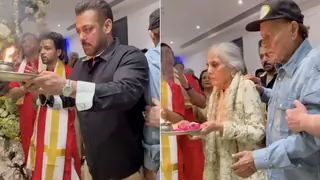Monday, July 25, 2011
Tashan Mein...
Tashan (Style) was the brain child of one man ' director Vijay Krishna Acharya (aka Victor.) An English literature graduate from the Uttar Pradesh town of Kanpur, Victor got his start in the industry writing for serials and soap operas. Then came Dhoom (2004) and Dhoom 2 (2006) for which he wrote the scripts and dialogues. Those two films brought a light-hearted masala back to cinema halls with an engaging mix of soapy melodrama and action-comedy that had been missing from Hindi films for a few years. The films, especially the second, did bumper box office business. It only makes sense that Yash Raj, who had produced the Dhoom's would allow Victor to have free reign to write and direct something of his own.
When Tashan was announced in early 2007, nobody could have predicted the circumstances that would lead to the most prying of media scrutiny and the most hysterical of speculation. When it was announced, heroes Akshay Kumar and Saif Ali Khan were firmly on the B-list, racking up some successes but nothing approaching Three Khan territory, although their pairing did generate some heat because they had co-stared in a series of fondly remembered action-comedy films from 1990s that featured Akshay as the rough and tumble Khiladi and Saif as his urbane secondary hero. Anil Kapoor was a well-loved but past-sell by date hero. Initially, all the real buzz was behind the heroine of the film - Kareena Kapoor.
Tashan found Kareena at a pivotal moment in her career. For the last few years she had languished - for the most part - in the second tier of heroines. While Rani, Preity, and Pryianka had their pick of Three Khan projects, Bebo was working with Fardeen Khan, Abhishek Bachchan, Akshay Kumar (before his 2007 revival,) and her then-beau Shahid Kapoor. But then something changed - Bebo began heating up. She sizzled in a well-received item number from Shahrukh Khan mega-hit Don: The Chase Begins - "Yeh Mera Dil." And did it again in "It's Rocking" a few months later. She broke up with her serious (and noted wet blanket) boyfriend Shahid Kapoor and underwent a style transformation. Bebo was reborn as the It Girl.
To fully understand the Bebo-mania that ballooned in the run up to Tashan, one needs to understand two things Bollywood gossip scribes hold dear 1) the link-up and 2) the illicit appeal of the bikini. The link-up is an increasingly overused weapon in a film's public relations arsenal and it usually means having stories carefully placed about so-and-so 'getting closer' to their buxom co-star on set, with the media gladly playing along by accosting both parties about their relationship with the other during any interview opportunities. The bikini, on the other hand, is like the holy grail of pervy desi film viewers. Unlike American films, which have had actresses poured into bikinis since Annette Funicello romped on Muscle Beach (although Ms. Funicello was never permitted by Disney to wear one) in the early 1960s, most Bollywood heroines would never be seen in anything more revealing than some sort of midriff baring dance costume or perhaps a cocktail dress.* Through years of Baywatch and other Western output, the bikini became mythologized and overtly sexualized. It wasn't just a swim suit or an item of clothing - it was the symbol of ultimate female desirability.
Meanwhile, as reports were coming from set of Kareena fainting from hunger, other reports were trickling out of her 'getting close' to co-star Saif Ali Khan but Kareena was still publicly together with her boyfriend Shahid.. Now, as Tashan was in the middle of filming, another film of Kareena's was gearing up for release - a film called Jab We Met that co-starred that very boyfriend - and right before Jab We Met was going to release in October, Kareena and Shahid announced they had split up. All this was too much drama for the media and rumors flew fast and furious that Saif had broken the couple up; that the split was a publicity gimmick.** When Jab We Met was a huge success, combined with the huge drama, it only increased the amount of attention focused on Tashan.
But if Kareena's body heat was not the only niggle to this tale, because not only was Kareena catching on fire in 2007, Akshay exploded. Almost immediately after Tashan was announced, Akshay Kumar had one of a mind-boggling four monster hits with Namastey London. The legend of Akshay Kumar just grew and grew through the year as the hits ticked by. By the time Tashan finally rolled around in 2008, it wasn't just an Akshay Kumar film it was set up to be the fifth Akshay Kumar monster hit in a row.
And then there were the promotions that ramped up as 2008 began. The film was hyped as the ultimate in style - slick, cool, sexy, and oh, so, glamorous.*** Kareena had her Size Zero brand firmly in place; Akshay Kumar was allegedly personally made over by the head of Yash Raj Films himself, Aditya Chopra; Anil Kapoor wasn't even allowed to discuss his character; and Saif was just going to be looking cool. Tashan was going to be the best thing since sliced bread; the biggest box office hit since, well, Dhoom 2; the film that sets style trends for years to come! Instead, it flopped so badly that the force of impact could be felt from Chandni Chowk to China... although Bebo's Size Zero look did heat up a starlet starvation trend. So, if the buzz was definitely there, what went wrong?
On the surface, Tashan seems like basic masala - tragic events in childhood, lost and found, henchmen in funny costumes - but the film goes much deeper than that. Victor Acharya stuffed his film full of meta-narrative commentary and meta-narrative comedy. The first half sees Victor, the former English literature student, picks apart the role of English in contemporary films, mocking how ridiculous Hinglish can sound and poking at the boundaries of the town-country language clash. And it also sees Victor, the screenwriter, gets in a dig or two at the expense of some of the more vapid films to enter the market in the 2000s. Finally, in the second half, Victor, the masala fan takes over and the film spins off into Johny Mera Naam territory - a film that he specifically references in an interview.
Talking about the scene with Bachchan and Pooja on the boat, Victor said, "To me, this scene is pivotal, as it reveals Bachchan Pandey's positive side -- his innocence. The film gets a soul because of Bachchan's flashback. This scene, I feel, elevates the film from being just an entertainer. It is inspired by Manmohan Desai's lost and found formula, plus Vijay Anand's Johny Mera Naam."
This desire for soul is what kept Tashan from being the stylish, slick entertainer it was sold as. When Victor mentioned Johny Mera Naam, I knew exactly the scene he was talking about - eternal baddie Pran discovers his true background and joins forces with the hero to defeat a bigger baddie. I can still picture the expression on Pran's face when he finds out he is in the presence of his real family, a combination of overpowering shock and sadness and happiness and disbelief; it's the same facial expression that Bachchan makes when he discovers Pooja's true identity. Unfortunately for Victor, audiences didn't want his version of a masala film with soul, they wanted an entertainer.
I've written extensively on Tashan before and probably will write more on it later. One thing I've grappled with over these years is the role of masala in both Tashan and Bollywood in general these days. In the wake of Wanted and Dabangg, masala does seem to be making a comeback. We're seeing villages and villains making a comeback, along with that most wonderful of songs - the item. While it's possible that Tashan was released just a bit too early - that if it came out now, it might make a better impression - I don't think that's the case. Tashan successfully straddles two disparate forms of storytelling, 70s style masala and high level meta-narrative commentary, but it does so in a way that alienates mainstream audiences. The more I watch popular "throwback" films like Dabangg, the more I see that Tashan failed at the box office because it wasn't accessible. An audience who would have enjoyed the masala elements, most likely found the meta elements either dull or incomprehensible. And an audience drawn in by cool Jimmy Cliff, would have been baffled by the unironic take on masala. Basically, the only people Victor succeeded in reaching in Tashan were people like himself - highly media literate with a genuine and unironic fondness for films like Johny Mera Naam and a disdain for films like Hum Tum.
And speaking of Hum Tum, it's worth discussing Saif Ali Khan's role just a bit in all of this. Saif Ali Khan made solo hero status on the basis of urbane, Hollywood-influenced romantic comedies like Hum Tum. These are films that (for the most part) romanticize the mundanities of the (upper) middle-class English-tinged lifestyle and Tashan has no place for them. The entire opening sequence with Saif is set up as if it was one of these middle-class rom-coms, an illusion that is shattered when Bachchan Pande roars in on his motorbike. From that point forward, Saif Ali Khan is pushed back into secondary hero status and the film enters real masala territory. The casting coup of having the ultimate yuppie hero play the ultimate yuppie hero cannot have been lost on Victor, but, like others I do wonder what Saif saw in the role, unless he simply wanted a change from Yuppie-chusetts and saw the opportunity to go kick butt with his friend Akshay again in Masala Pradesh. I can understand that.
As for Saif's partner-in-Agent Vinod, Miss Bebo, Tashan did wonders for her. And the Size Zero gambit worked like a charm. Although she has gone back to a plumper shape, nobody picks on her weight in the media anymore.*****
And Box Office King Akshay went on to have a big hit with Singh is Kinng a couple months after Tashan.
The only one really slammed by Tashan was Victor. It took him four years to gather everything to make another film; he'll be writing and directing Dhoom 3.
Tashan has earned a special place in my heart over the last few years; I've seen it at least ten times and have written thousands of words on it. And every time I watch, I discover something new; this time I finally understand why it wasn't a hit. Tashan is too raw and too bloody for audiences who think masala is all about wacky costumes and implausible plots; Tashan is too meta for audiences who require entertainment to be easy; Tashan has eshtyle but that eshtyle is the inverted seams of Commes des Garcons not the glossy cover of People magazine. Those are the reasons it flopped and those are exactly the reasons I love it.
Perhaps a man can only make a film like this once. The uncompromising vision, having been rejected, will probably never make another appearance but I have high hopes that Victor will make something worthwhile out of Dhoom 3 and finally be able to put the failure of Tashan behind him as far as the industry is concerned. Because, as I see Dabangg and Wanted and Ghajini and Singham race to success, I think back on Tashan and know that Victor Acharya will be able to given us something that will blow them all out of the water.






































17